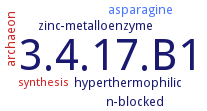3.4.17.B1: Sulfolobus solfataricus carboxypeptidase
This is an abbreviated version!
For detailed information about Sulfolobus solfataricus carboxypeptidase, go to the full flat file.

Word Map on EC 3.4.17.B1 
-
3.4.17.B1
-
hyperthermophilic
-
zinc-metalloenzyme
-
n-blocked
-
asparagine
-
archaeon
-
synthesis
- 3.4.17.B1
-
hyperthermophilic
-
zinc-metalloenzyme
-
n-blocked
- asparagine
- archaeon
- synthesis
Reaction
Release of basic, acidic and aromatic amino acids from the respective benzoylglycated and benzyloxycarbonylated amino acids. Slow hydrolysis of aliphatic amino acids. No activity with benzyloxycarbonyl-Pro and benzyloxycarbonyl-Trp =
Synonyms
carboxypeptidase, carboxypeptidase S1, CPS, cpsA, CPSso, M20.008, SSO1355, thermostable carboxypeptidase 1
ECTree
Advanced search results
Temperature Stability
Temperature Stability on EC 3.4.17.B1 - Sulfolobus solfataricus carboxypeptidase
Please wait a moment until all data is loaded. This message will disappear when all data is loaded.
20
stable for several days at room temperature in buffer containing 10 mM imidazole-HCl, 10 mM potassium acetate and 23 mM Tris-HCl, pH 7.2, in the presence of 2 mM 2-mercaptoethanol and 50% (v/v) glycerol
25
the enzyme gradually loses its activity resulting in a complete inactivation after 96 h. The nanobioconjugate of the enzyme immobilized on silica-coated magnetic nanoparticles leads to a substantial increase in stability, up to 85% of initial activity being retained after 96 h
40
in the presence of ethanol at 40°C and various concentrations the inactivation profiles shows that the enzyme has a residual activity of 50% after 6 h, which decreases to 20% after 24 h incubation. The nanobioconjugate of the enzyme immobilized on silica-coated magnetic nanoparticles reveales a significantly improved stability in ethanol at the different tested concentrations compared with free enzyme, up to 80-90% of residual activity after 6 h, and 70% after 24 h incubation in 80% ethanol being retained
50
70
inactivation rate constants of both holo- and apo-enzyme is determined at 70°C over a broad pH range. At pH values below 5.7, the metal-depleted enzyme is substantially more stable than the native form, a probable consequence of a reduction in electrostatic repulsion. In contrast, at any pH value above 5.7 loss of Zn2+ severely impairs enzyme stability. Below pH 5 the apoenzyme is also significantly destabilized
80
90
additional information
in the absence of glycerol and 2-mercaptoethanol, at 50°C, the enzyme undergoes a slow thermal inactivation upon dilution in an aqueous buffer at pH 6.5. This loss of activity can be inhibited when the enzyme is maintained at high pressure. At higher temperatures, higher pressures (up to 400 MPa) are required to maintain the enzyme in its active state
50
after 1 h of incubation at 50°C and 1 MPa in the absence of substrate, the activity is decreased by 30%. This effect is abolished when the enzyme is incubated at 200 MPa. Activity loss at atmospheric pressure is about 7% in 10 min, the activity can be stabilized completely at 300 MPa
holoenzyme is stable at 80°C, while the apoenzyme is rapidly inactivated
80
first-order irreversible thermal inactivation of the metal-depleted enzyme shows an activation energy value of 205.6 kJ/mol, which is considerably lower than that of the holoenzyme (494.4 kJ/mol). The values of activation free energies, enthalpies and entropies also dropp with metal removal. Thermal inactivation of the apoenzyme is very quick at 80°C, whereas the holoenzyme is stable at the same temperature. The bivalent cation exhibits a major stabilizing role. Chaotropic salts strongly destabilize the holoenzyme, showing that hydrophobic interactions are involved in maintaining the native conformation of the enzyme. The inactivation rate is also increased by sodium sulfate, acetate and chloride, which are not chaotropes, indicating that one or more salt bridges concur in stabilizing the active enzyme
90
enzyme looses activity at the rate of 25% in 10 min, a pressure raise of 400 MPa results in a 4fold decrease of the inactivation rate
hydrophobic interactions between Leu7 and Leu376 increase protein thermostability
additional information
-
hydrophobic interactions between Leu7 and Leu376 increase protein thermostability


 results (
results ( results (
results ( top
top






